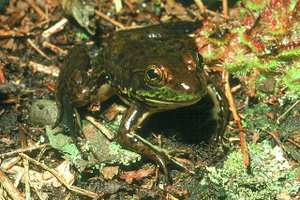Lithobates septentrionalis
The strong odor of mink frogs may serve as an anti-predator mechanism, but these frogs are nevertheless eaten by great blue herons, raccoons, giant water bugs, and other animals.
Photo Credit: Geoffrey A. Hammerson
Lithobates septentrionalis
Common Name: mink frog
Other Scientific Names: Rana septentrionalis
Animal Guild: Amphibian
Class > Order > Family: Amphibia > Anura > Ranidae
What does the species look like?
Mink frogs are green to olive-gray, with dark spots or mottling on the back. Sometimes there is a ridge along each side of the back but usually it is absent. The webbing between the hind toes extends to the last joint of the 4th toe and to the tip of the 5th toe (and does not reach this far in green frogs, Lithobates clamitans). Dark marks on the upper side of the hind legs form irregular blotches that are elongated along the long axis of each leg (versus a cross-banding pattern in the green frog). These frogs have odorous skin that smells like a mink or crushed scallions, especially if roughly handled. Maximum size is around 3 inches (7.6 cm) snout-vent length. The breeding call is a rapid, sharp "cut-cut-cut-ghrrr" or "tok-tok-tok-tok-tok;" a chorus may sound like distant hammering or horse's hooves on a cobblestone road. Larvae are greenish or brown with dark spots or mottling that may extend onto the tail; the belly is yellowish and opaque; the tail tip is long and sharply pointed (if not damaged); maximum total length is about 4 inches (10 cm). Egg masses are globular, about 3-6 inches 7.5-15 cm) in diameter, and contain several hundred eggs.
Where is the species found?
States & Provinces
MB, ME, MI, MN, NB, NH, NL, NS, NY, ON, QC, VT, WI
Distribution
Range extends from Labrador to southern Manitoba, and south to northern New England and northern Wisconsin.
Mink frogs inhabit cold lakes and ponds and their shallow peripheral pools, and slow-moving inlets and outlets of ponds and lakes, often among emergent or floating vegetation (e.g., lily pads) in open water or along shores. They are highly aquatic but sometimes venture away from water onto land during very wet weather. Eggs and larvae develop in permanent lakes and ponds. Eggs are attached to submerged vegetation, especially the stems of water lily or spatterdock, but may later sink to the bottom, where the eggs complete their development.
General Phenology and Life History
Most activity occurs from May to October. Hibernation sites are underwater in permanent water bodies. Breeding occurs in late spring and summer, mainly late May to early August (peak often June-July). Adult females deposit clutches of at least several hundred eggs, June to August. The aquatic larval stage lasts 1-2 years. Adult males reach sexual maturity one year after metamorphosis while adult females do so at 1-2 years after metamorphosis.
Which phenophases should I observe?
Do you see/hear...?
Activity
Adults on land More...
For abundance, enter the number of individual animals observed in this phenophase.
Adults in water More...
For abundance, enter the number of individual animals observed in this phenophase.
Adults feeding For abundance, enter the number of individual animals observed in this phenophase.
Reproduction
Vocalizing What is the intensity of vocalizing?
Single calls: There is space between calls and individuals can be counted. Overlapping calls: Calls of individuals can be distinguished but there is some overlapping of calls. Full chorus: Calls are constant and overlapping.
Mating For abundance, enter the number of individual animals observed in this phenophase.
Fresh eggs For abundance, enter the number of individual animals observed in this phenophase.
Development
Dead adults For abundance, enter the number of individual animals observed in this phenophase.
What do these phenophases look like?
There is currently no photoguide available for this species. If you'd like help us create one, use the guidance document and species template provided here . Then send it via email to education@usanpn.org when it is complete.
